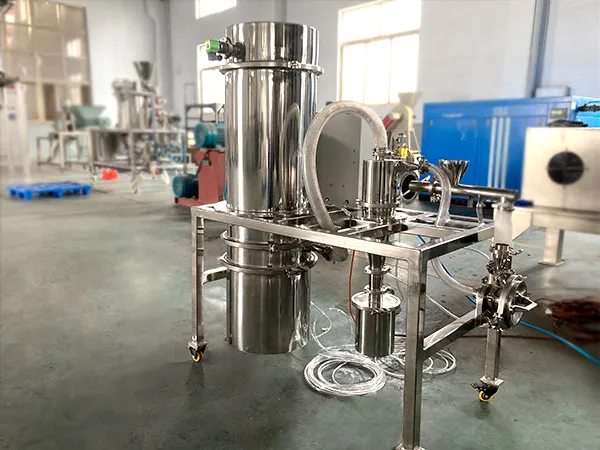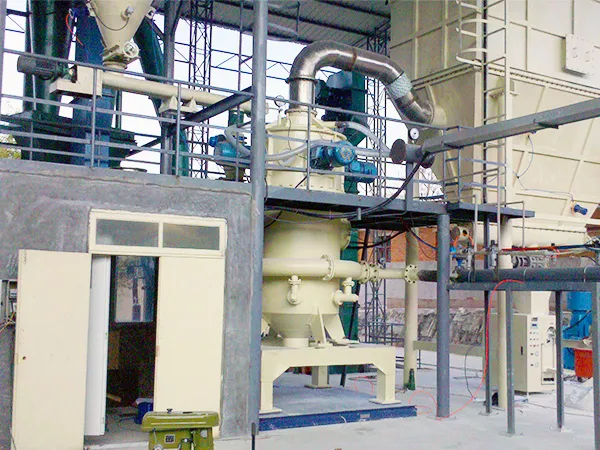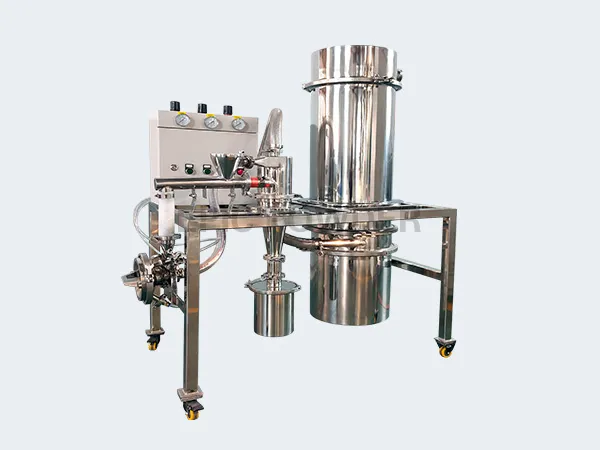As an important method for preparing ultrafine powders, air pulverization technology can produce various high-performance micro-powder materials.
Based on the depth of powder processing technology and the changes in the physical and chemical properties and application characteristics of powder materials, we call fine powders with a particle size of less than 10 μm as ultrafine powders. With the development of science and technology, many industries require solid materials in powder form as raw materials.

These powders must have a smaller particle size, high purity, and no other impurities. There are also requirements for the powder’s particle size distribution. Therefore, the application field of ultrafine powder pulverization technology and equipment is expanding. Scientific researchers are paying more attention to and placing greater importance on ultrafine pulverization technology and equipment.
Characteristics of Air Pulverizers
Air pulverizers, also known as jet mills, use high-speed jet to cause materials to collide, impact, shear to achieve pulverization. The product obtained by pulverizing material with an airf jet mill has uniform fineness, a narrow powder particle size distribution, high purity, smooth particle surfaces, regular shapes, and good dispersion.

During the pulverization process, the material is less contaminated, and it can even be made pollution-free and sterile. Therefore, it can be applied to ultrafine pulverization in areas such as food and medicine, where contamination by foreign objects is not allowed. The airf jet mill does not release significant heat during the pulverization process, making it more suitable for pulverizing low-melting-point or heat-sensitive materials compared to other pulverization equipment. The production process is highly automated and can be used for large-scale industrial production.
Air pulverization can also facilitate the combined operation of pulverization and subsequent production steps, such as simultaneous pulverization and drying of materials. Additionally, solutions can be sprayed during pulverization to coat or surface-modify the powder. However, it has disadvantages, such as high energy consumption.
Application of Air Pulverizers
In the fields of military and aerospace, ultrafine powder materials are used to manufacture stealth materials, such as stealth aircraft and stealth tanks. Rocket propellants made from products obtained by pulverizing oxidants, catalysts, etc., can burn more than twice as fast as conventional ones.
In the field of electronics, ultrafine iron oxide powder is used to produce high-performance magnetic materials. Ultrafine silicon oxide powder is used to produce high-performance resistor materials. Ultrafine high-purity alumina powder is used to manufacture sapphire substrates for LED chips. Substrates made from ultrafine powder have the characteristics of good stability, excellent light transmittance, and non-absorption of visible light. After treatment by air pulverization technology, the particle size of molybdenum powder decreases. Its particle size distribution becomes narrower, its morphology becomes uniform, and both its loose density and tap density improve. This enhances its use in the production of light bulbs, electron tubes, and integrated circuits.
In the field of new energy, the average particle size of materials processed by air pulverization is fine. The distribution is with a narrow particle size. The particle surfaces are smooth, the particle shapes are regular, the purity is high and the activity is large. These mean the dispersion is good. These properties meet the preparation requirements for electrode materials, making air pulverization technology widely applicable. Typical materials suitable for air pulverizers include lithium manganese oxide, lithium cobalt oxide, lithium iron phosphate, lithium carbonate, spherical graphite, petroleum coke, asphalt coke, ternary materials, nickel-hydrogen alloy, ferrous oxalate, lithium titanate, and lithium nickel manganese oxide.

Air pulverization technology is an important technical method for micro-nano powder processing, and its research can effectively improve resource utilization.
Epic Powder Fluidized Bed Jet Mill

Ceramic fluidized bed jet mill is a type of milling equipment used in the manufacturing industry to produce fine powders. This technology is widely used in industries such as pharmaceuticals, chemicals, and food processing. This fluidized bed jet mill is an efficient and flexible milling system that is capable of producing particles of various sizes and shapes.
The ceramic fluidized bed jet mill consists of a milling chamber, a fluidization chamber, and a gas supply system. The milling chamber is where the grinding process takes place. It is lined with wear-resistant ceramic tiles to protect the chamber from abrasion. The fluidization chamber is located above the milling chamber and is used to distribute the gas evenly throughout the milling chamber. The gas supply system supplies the gas used to fluidize the particles in the milling chamber.
Choose Epic Powder for efficient, energy-saving, and environmentally friendly powder processing solutions! Contact us to learn more about our products!